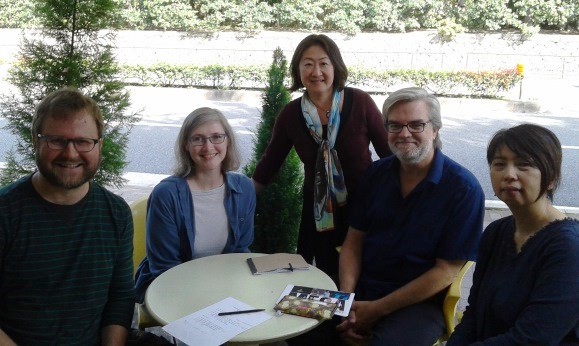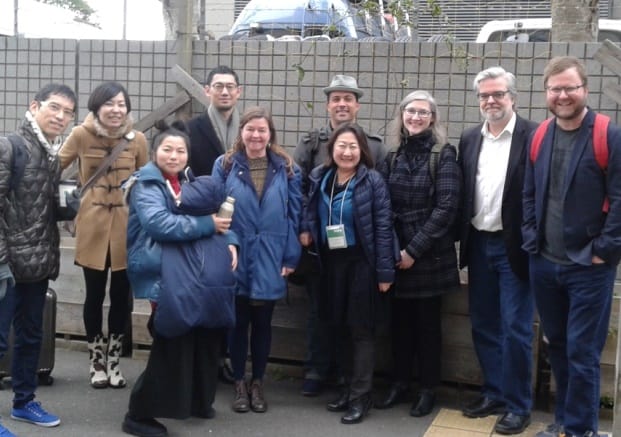Going Extra Miles
April 4, 2016 • 3 minute read
by Kyoko Yoshida, U.S./Japan Connection Consultant

On a sunny October morning in a meeting room of the newly opened Kyoto Experiment Festival office, I looked around the table and said to myself in appreciation, “a small miracle happened again.” Curators for NPN’s Asia programs arrived in the old capital of Japan after visiting Seoul and Gwangju, South Korea and Tokyo. Their travels originated from Burlington, VT; Austin, TX; Chicago, IL; and I flew in from San Francisco, to meet with the Japanese partners based in Kyoto and in Kobe (Hyogo prefecture). I wondered, how many international and domestic miles and hours of travels combined in the room to make this bi-national dialogue happen? Not to mention how much we each do – presenting artists, developing audiences, planning and fundraising for festivals, seasons, field convenings and advocacy, etc, – managing deadlines and adjusting schedules to all be here!

At this October meeting, the six curator-partners and NPN staff rolled up their sleeves and really kyokin-wo-hiraita (opened up and talked ones’ mind) as we started to discuss the practical framework of artistic exchange.
The U.S./Japan Connection: Building a Community, the convener of this meeting, is NPN/VAN’s program that nurtures cultural exchange between artists and organizers in both countries through learning, relationships, and reciprocity. Leading up to and during this meeting, the Japanese partners articulated their concerns around the conditions and typical models through which Japanese performing artists are creating work. Of particular note was the “short-sightedness” in Japan of the creative process demonstrated by very restricted application windows of major grant programs (between the announcement and the deadline) and the scarcity of multi-year funding programs. Also there is a lack of infrastructure and market for touring work within Japan, as most arts philanthropy supports creation of new works, not tours. This situation seems to be causing stagnation, particularly in the contemporary dance scene in Japan. The Japanese representatives shared the insights that artistic products and projects have mostly become objects of consumption, be it a long running commercial musical theater piece or even an experimental small-scale solo dance performance, the former being for mass-consumption and the latter being for self-satisfaction.
The Japanese partners then expressed their desire and ambition to create a new framework together with the U.S. partners that can trigger even small changes in these trends – even though the United States is perceived as the leader in global economic consumerism. How can NPN not respond to this?
Inspired, and also recognizing both similar and different challenges faced by artists in the U.S., Links Hall proposed an initial structure that the bi-national team has been collectively designing, temporarily called “creative residency and tour exchange.” Through this model, Japanese and American artists will create new works side-by-side in residencies in both countries and present/tour the works that come out of the residencies. Unlike existing models of “international collaboration” practiced in the field, in which the artists from different countries create one production together, the artists will create two respective productions, but share the creative process with each other by actively interacting and giving feedback, criticism, and stimulation to each other during the residency. The exchange will also provide facilitation and interactions by creative minds from different industries during the residency – meeting various needs as agreed upon by the artists.
While honing the details, timelines and funding strategies, the partner-curators also organized and attended live showcases in Chicago, Austin, Kyoto, Kobe, and at the Tokyo Performing Arts Meeting in Yokohama and at NPN’s Annual Meetings in Tulsa, OK and Portland, OR. Some of these have been reported in past editions of the E-news. Very soon, we will be making an announcement of the artists participating in this new exchange program.
This is just one part of the whole picture, as we have also been working on and making a series of panel presentations regarding arts and disaster relief/preparedness, as well as socially engaged art. The next report from the U.S./Japan Connection will feature our recent visit to Tohoku, the region of Japan that was most affected by the 2011 earthquake and tsunami, to share some new developments!